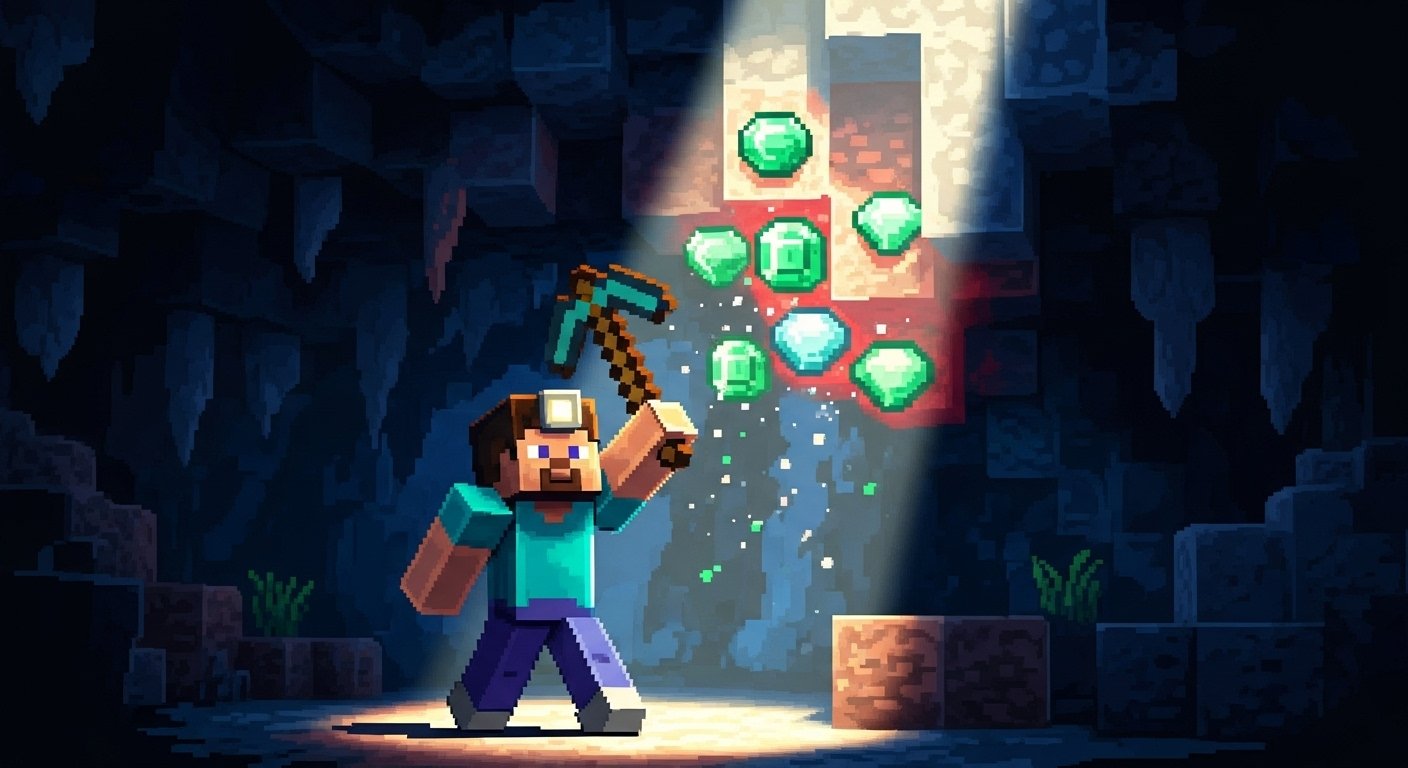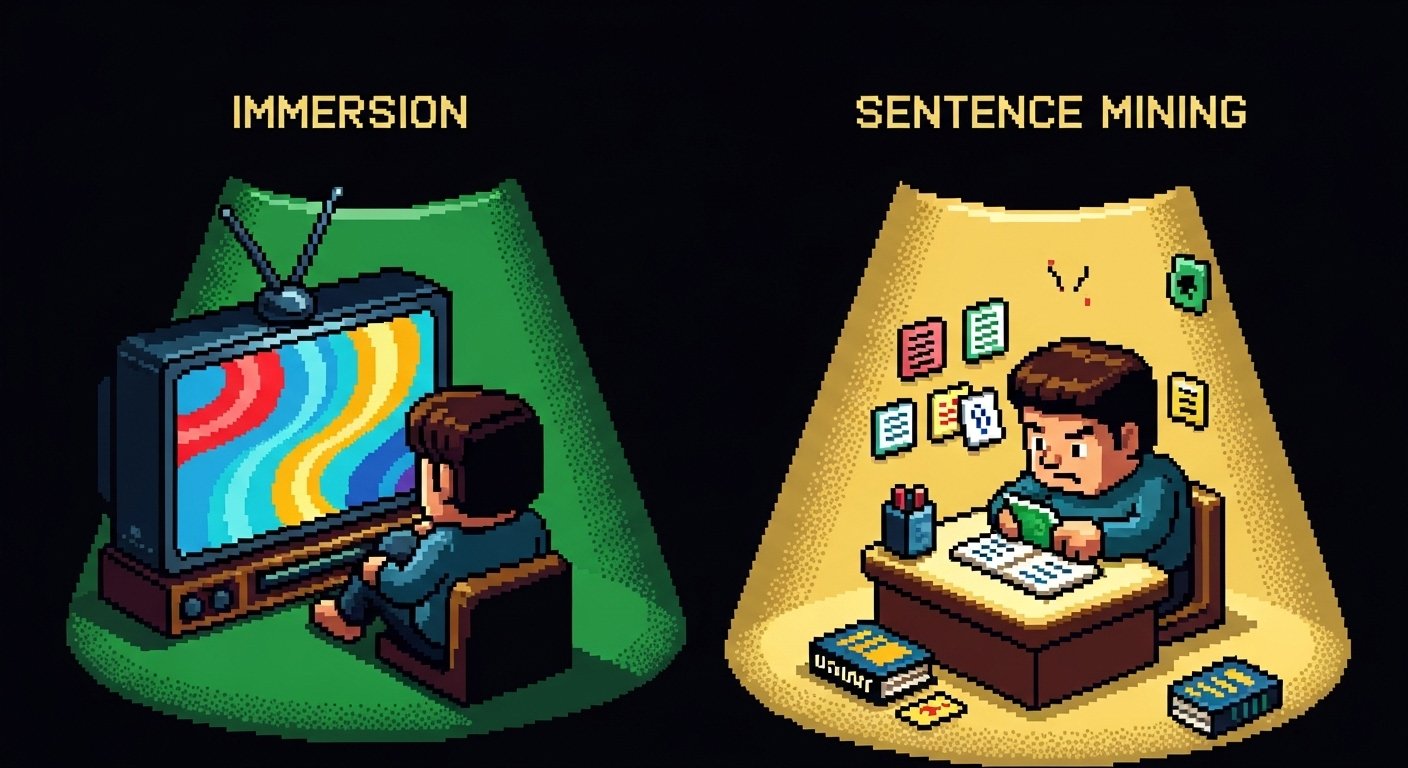Not A Subscriber?
Join 752+ language learners getting mindf*cked every Saturday morning while getting Immersed.
October 18th, 2025 | Ademola Adeyemi
A Complete Beginner's Guide To Sentence Mining (Without the Burnout)
I struggled for months wanting someone to tell me exactly this:

This guide will not tell you to make cards for every word you encounter.
Most learners burn out doing that anyway, and clogging your deck with every unknown word will just overwhelm you.
But here’s the thing about sentence mining that nobody tells you upfront: You’re going to have questions I can’t answer in one newsletter.
Not because the answers don’t exist, but because some questions need to be experienced before they make sense.
So before we start, I want to map out where you are and what you might need:
If you’re brand new to this whole SRS thing:
You’re probably wondering “What even is an SRS and why does everyone act like I should know?”
Trenton’s video on the SRS explains why this system exists better than I can in 3 paragraphs. Watch it. It’ll click.
For actually getting started with decks, these two saved me:
They’re free. They’re not perfect. But they got me my first 1,000+ words before I knew how to mine my own.
If you understand the basics but struggle with comprehension:
Matt vs Japan’s video on why you can’t understand sentences (even when you know all the words) answered questions I struggled with for months.
This is the “why” behind sentence mining. Not the how—the why it works when vocabulary lists don’t.
If you’re ready to mine but don’t have tools set up:
I use Migaku for everything now. One tool. That’s it. (Not sponsored, but that referral code gives you a free month.)
Some people prefer Language Reactor for YouTube/Netflix mining. Both work. Pick one and stop shopping for tools.
Now that you know where to find what I can’t cover here, let’s talk about what this guide will give you:
This is not about being perfect. You will make cards that you didn’t need. You will skip words you should have mined. That’s normal. The system works despite imperfection, not because of it.
Mining is not immersion. They are two completely different activities with different goals. Confusing them is the fastest way to frustration. (I’ll break this down in detail—it’s critical.)
You don’t need sentence mining to learn a language. But if you want to learn faster, more efficiently, and with less frustration about forgetting words—this is the most effective study method I’ve found in 5 years.
Those principles will make more sense as we go. For now, just know: sentence mining is a tool to make your limited study time devastatingly efficient.
Sentence mining is composed of one blocking word per card with context from your actual immersion experience in the form of audio, text, and meaning.
That’s the structure. Let’s break down why it matters.
What Sentence Mining Actually Is (The Two-Activity Principle)
Most people think sentence mining is just “studying while watching shows.”
Wrong.
Sentence mining and immersion are two separate activities. Understanding this distinction will save you months of confusion.

Immersion is:
- Enjoying content for its own sake
- Forgetting you’re even learning
- Your subconscious brain acquiring language
- The thing that actually makes you fluent
Mining is:
- Active learning with a specific goal
- Conscious, analytical puzzle-solving
- Creating flashcards from blocking words
- The thing that makes immersion more comprehensible
Think of it like this: Immersion is playing basketball. Mining is lifting weights so you’re stronger when you play.
I call sentence mining “immersive studying” because you’re using real, native content to study from. You’re not translating textbook sentences. You’re not memorizing vocab lists your teacher chose.
You’re building your curriculum from your actual experience with the language.
This is the hierarchy of how it works:
1 Mining Session (1 hour)
- Goal: 10 cards with blocking words
- 3-5 Immersion Touchpoints (the shows/content you mine from)
- 1 Blocking Word Per Card (not entire sentences, just what blocked you)
String these together as a daily habit and you have the most efficient study system possible.
When you’re sentence mining, the reason you feel stuck or overwhelmed is because you’re trying to mine everything instead of strategically selecting what won’t stick naturally.
At that point, looking up more words isn’t going to help you. You need better decision criteria.
If that doesn’t work, sometimes you need to trust your brain. Your brain will acquire some words naturally without cards. Making a card for everything is how you burn out.
The Prerequisites (What You Need Before You Start)
How do you know when you’re ready to start sentence mining?
The honest answer: You need about 1,000 foundational words first.
Without that base, there’s too much unknown to grasp context. You can’t mine effectively when every sentence has 5+ unknown words.
This is the specific barrier most beginners face: You want to start mining immediately, but your comprehension isn’t there yet.
Here’s how to overcome it:
Use frequency lists or Migaku’s foundational resources
- The 1,000 most common words in your target language
- These are the words that appear in EVERY conversation
- Build this base first (takes about 3 months at 10 words/day)
Why this matters:
If you try to mine too early, you’ll encounter sentences like:
“저는 어제 친구하고 영화관에 갔어요”
If you don’t know 저는, 어제, 친구, 하고, 영화관, and 갔어요… that’s 6 unknowns in one sentence.
That’s not sentence mining. That’s chaos.
But with 1,000 words, you encounter sentences like:
“저는 어제 친구하고 영화관에 갔어요”
Now you know: 저는 (I), 어제 (yesterday), 친구 (friend), 하고 (with), and 갔어요 (went).
The only unknown? 영화관 (movie theater).
That’s mineable. One unknown in a sea of known = perfect.
The other requirements:
- Subtitles or a script (you need to see the words to look them up)
- A dictionary (not a translator—we’ll get to why later)
- An SRS system (Anki or Migaku to review your cards)
- Content you actually want to watch (interest-driven is non-negotiable)
One note on subtitles: You can’t effectively mine what you can’t identify.
Listening to content without subtitles is great for immersion. It’s terrible for mining. They’re different activities, remember?
If you don’t have subtitles for something, just watch it for enjoyment. Don’t stress about mining it. You’ll have plenty of other content that does have subtitles.
The 10-Card Framework (The Instruction I Desperately Wanted)
This may not make sense until you experience it, but having a daily mining goal transforms your learning.
Because specificity eliminates decision paralysis and your brain naturally strategizes toward clear targets.
When you know you need 10 cards today, your mind subconsciously filters what’s worth mining versus what your brain will hold naturally. You stop agonizing over every unknown word.
This is why it’s incredibly important to have a number: You need constraints to build prioritization skills.
A note for beginners: You probably won’t hit 10 cards in your first week. That’s fine. Start with 5. The framework matters more than the exact number.
The math behind 10 cards per hour:
60 minutes ÷ 10 cards = every 6 minutes, look up and create one card
Now, you’re probably thinking: “But what if I encounter more unknowns? What if I only encounter 5?”
The framework is flexible. Some days you’ll mine 8 cards. Some days 12. The goal is sustainable pacing, not rigid perfection.
I struggled for months wanting someone to tell me exactly this. Every guide said “mine sentences” but never how often or what to prioritize.
Here’s what actually happens in a 1-hour mining session:
Minutes 0-6: Watch content, encounter something unclear
- If it bothers you = pause and investigate
- If it doesn’t = keep watching
Minutes 6-12: Second potential card
- Did that word from minute 3 reappear? → Card it
- New word that bothers you? → Investigate
Minutes 12-18: Third potential card
- Pattern recognition kicking in
- You start feeling which words won’t stick naturally
This rhythm prevents two disasters:
- Looking up too much (burns you out in 20 minutes)
- Looking up too little (you make no progress)
Contrary to popular belief, mining faster isn’t better. Sustainable beats heroic every single time.
I can’t tell you exactly which words to mine or when to pause, but I can give you decision criteria that makes it obvious.
When to Make a Card (And When NOT To)
As you can tell, not every unknown word gets a card.
Some words your brain will acquire naturally. Others need the flashcard system to stick.
The question is: How do you know the difference?
When I analyzed my own mining patterns over 5 years, I noticed two categories:
MAKE A CARD WHEN:
The “Bothered You Before” Test
- You have recollection of encountering this word
- Your brain goes: “Holy crap, I’ve looked this up before!”
- The sound is clear in your mind but meaning is missing
- It keeps blocking your comprehension
The “Emerged From Fog” Test
- Word has appeared multiple times this week
- You looked it up earlier (today or yesterday) and forgot
- It’s not sticking naturally despite exposure
When I don’t know how to decide on a word, I cycle through these tests in my head and either trust my brain or make the card.
DO NOT MAKE A CARD WHEN:
The “Immediate Aha” Test
- You look it up once and immediately understand
- Your brain goes “Ah, that makes sense!”
- No prior struggle with this word
- First encounter, context made it clear
After making a decision with 1-2 word encounters, I follow up with action. I either resume watching or I create the card.
If you’re good at self-awareness, you could use this decision framework:
I’m watching a show. I encounter a word I don’t know. I pause.
Internal questions:
- Have I struggled with this before? (yes = card | no = skip)
- Did I just “get it” from context? (yes = skip | no = card)
- Is this blocking my enjoyment? (yes = card | no = skip)
- Am I just being completionist? (yes = skip | no = card)
Now, this process may seem long, but that’s how the skill develops. It takes conscious effort at first, and once it becomes second nature, you don’t even think about it.
The secret most people miss:
If you make cards for words that immediately make sense, you’re not trusting your brain to do its job. Your brain will acquire some words naturally from sheer exposure.
The SRS exists for words that won’t stick on their own.
So, from my example framework above, I could also ask:
- “What if I mine it and never see it again?” (Then it wasn’t high-frequency—that’s fine)
- “What if I skip it and forget it forever?” (If it’s important, it’ll appear again)
From those questions, you realize: You can’t mine everything, and trying to is what burns you out.
I personally wouldn’t stress about missing words, because there’s one secret:
If you leave words unmined, they’ll reappear if they matter. Language has natural repetition. Trust the process.
The Mining Process (6-Step System)
The biggest problem with sentence mining guides is they say “mine sentences” but never show the actual workflow.
If you follow these 6 steps, you’ll rarely feel lost.
And if you do, you can return to these whenever you need clarity.
This is less of a mining process and more a guide to systematic decision-making.
Step 1: Encounter The Unknown
Watch your content with subtitles on.
Don’t pause immediately when you see an unknown word.
Let the context wash over you first. Sometimes the next sentence clarifies everything.
For the sake of example, imagine I’m watching a Korean drama and hear:
“그 사람 진짜 답답해”
I understand: “That person really [something]”
The word 답답해 is hazy. I’ve maybe heard it before. The sound is familiar but meaning is missing.
Step 2: Check Your Recognition
Before looking anything up, ask yourself:
“Have I encountered this before?”
If yes → Proceed to Step 3 If no, and context made it clear → Skip it, resume watching If no, but it’s blocking comprehension → Proceed to Step 3
In my example: Yes, I’ve heard 답답해 before. Multiple times. Still don’t know what it means.
This is prime mining material.
Step 3: Look It Up (Dictionary, Not Translator)
Pause the content.
Open your dictionary (I use Naver Dictionary for Korean).
Look up ONLY the blocking word. Not the full sentence.
Why? Because you want to test your understanding of everything else. Translation trains translation. Dictionary lookup trains comprehension.
답답해 = “frustrating, stuffy, feels blocked/stifled”
Ah. “That person is really frustrating.”
Step 4: Decide If This Needs A Card
Now you have the definition. Ask:
“Will I remember this naturally, or does this need the SRS?”
In this case: I’ve encountered it multiple times and kept forgetting. This needs a card.
If I looked it up and went “Oh obviously, duh” → No card needed. My brain has it.
Step 5: Create The Card (One Blocking Word Only)
Here’s where most people overcomplicate.
Your card should be dedicated to the ONE word/grammar that blocked you.
Not 3 words. Just the blocking word.
Front of card: Audio of the sentence (or just the word) Back of card:
- Korean text: 답답해
- Definition: “frustrating, stuffy”
- Maybe the full sentence for context
That’s it. Takes 2 seconds with Migaku. Used to take me 1 minute manually.
Step 6: Resume Watching
Don’t spiral into “let me mine 5 more words real quick.”
You made your card. Back to immersion.
The 6-minute timer starts over.
Around minute 12, you’ll encounter your next potential card.
Now, this workflow may seem mechanical, but that’s how mining becomes automatic. You train the pattern until it’s effortless.
One meta-note: You’re not trying to understand every word in the show. You’re strategically capturing words that won’t stick naturally so future immersion becomes more comprehensible.
That’s the whole point.
Tools & What Comes Next
We covered the system, not the tools.
Why? Because the system works regardless of tools. You could do this with pen, paper, and a dictionary.
But I’d be lying if I said tools don’t matter.
My setup (then vs. now):
2020-2021 (Manual era):
- Naver Dictionary (browser shortcut for speed)
- ShareX (screenshot audio from shows)
- Chrome extension (capture subtitles)
- Anki (manual card creation, ~1 minute per card)
- Samsung phone (Anki Droid with gesture controls)
2021-Present (Migaku era):
- Migaku (does literally everything)
- Card creation: 2 seconds
- Dictionary integration: built-in
- Audio capture: automatic
- Subtitle parsing: automatic
- AI-generated subtitles: for content without subs
I’m not exaggerating when I say Migaku is the only tool I use now. It’s the best investment I made in language learning, and everyone I’ve worked with who uses it never goes back.
But if you want free options, the manual system I used for 2 years works perfectly. It’s just slower.
That’s most of what you need to know to start sentence mining.
If you’re wondering what’s next:
Start with one show. One episode. Goal: 5 cards (not 10—start smaller).
Watch with subtitles. Pause when something bothers you. Look it up. Decide: card or no card?
You’ll know you’re doing it right when you feel slightly challenged but not overwhelmed.
And remember: You don’t need to mine everything you watch.
Some content is for pure enjoyment. Some content is for mining. Keep them separate and you’ll never burn out.
Additional resources:
For mining without subtitles:
- 5 Heart System Newsletter – the game I play when content doesn’t have subs
For understanding the technical setup (my old prehistoric system):
- Quickly Grabbing Audio with ShareX by Matt vs Japan – how I recorded and mined before Migaku existed
For complete beginners who need starter decks:
- Korean Grammar Sentences by Evita – my first 2,000+ cards
- Korean Vocabulary by Evita – companion deck
Everything mentioned above in one place for easy access.
Now go watch something. Pause when it bothers you. Make one card.
That’s how it starts.
Struggle Less. Acquire More. Enjoy Life.
Studied at Yonsei University. Worked in Korean politics. Reached fluency in 18 months through pure immersion.
Now I help language learners cut through the noise and achieve what most think is impossible.
Gain A New Perspective On Language & Life
I went from understanding 0% of Korean dramas to discussing politics at Yonsei in 25 months—using the same immersion principles I teach every Saturday.
